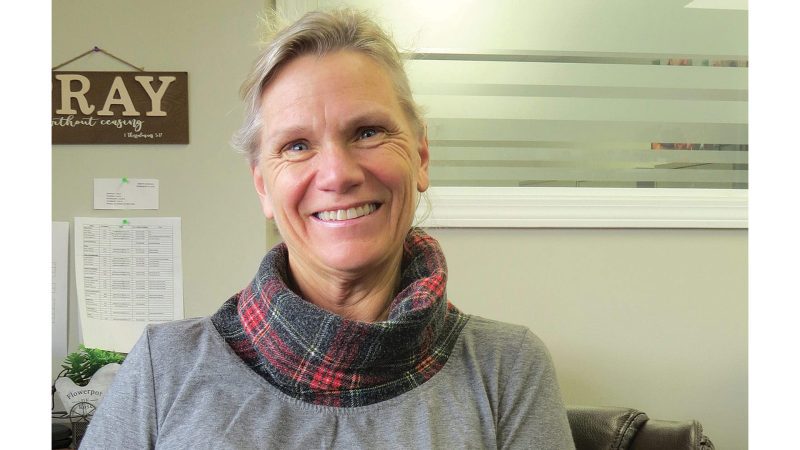Healthcare Workforce Shortage Has No Easy Solutions
Critical Condition
By Joseph Bednar

While workforce shortages in healthcare are not a new story, Spiros Hatiras said, COVID-19 certainly didn’t help the situation. Far from it.
“We had some challenges even before, but really, the pandemic has created a sort of crisis situation,” said Hatiras, president and CEO of Holyoke Medical Center and Valley Health Systems, noting that industry estimates peg current healthcare vacancies around a half-million jobs nationally. “There’s a mixture of reasons why they left, and a lot of them had to do with the pandemic.”
Essentially, he explained, many nurses and specialists have re-evaluated what they want to do for a living, while others who were close to retirement anyway decided to make that transition earlier than they might have. Others who had been part of a double-income household stayed home with the kids during the pandemic and decided they wanted to continue to do so.
“You have people who got burned out dealing with acute illness and decided to stay in the profession, but looked for a setting where they weren’t dealing with acute illness,” he went on. “Then you had some people with an existential crisis, saying ‘healthcare is not for me.’ We certainly had some of those. Put it all together, and we had a lot of folks leave the profession on the clinical side.”
Entry-level, non-licensed jobs in healthcare, like housekeeping and dietary services, have been a struggle to fill as well, Hatiras said, but nowhere near as difficult as on the clinical side.
Adam Berman also recognizes that these issues predate COVID. Well before the pandemic — for several years before, actually — Berman, president and CEO of Legacy Lifecare, would attend trade-association panels and conferences and speak with state and national colleagues, and one topic would always be at the forefront.
“We had some challenges even before, but really, the pandemic has created a sort of crisis situation.”
“It was always workforce, workforce, workforce,” he said. “This was pre-COVID, and it’s what kept providers up at night.”
However, at Legacy’s two partner companies, JGS Lifecare and Chelsea Jewish Lifecare, Berman agrees with Hatiras that the pandemic took an already-worrisome problem and worsened it.
“When COVID came, many individuals who may have been considering careers in healthcare went for it, but for others, COVID gave them pause. And some people elected to retire earlier than they were otherwise going to. For many people, there was the calculus of determining whether they’d stay at home taking care of somebody versus re-entering the workforce.
“That’s not just in healthcare; that’s in general,” Berman added. “You see it across every industry. There are fewer people overall than were previously in the workforce.”
The growing labor shortage in healthcare is starting to have serious bottom-line effects, as organizations boost wages to compete for scarce talent and swallow skyrocketing rates being demanded by travel-nurse agencies.
A recent study conducted by Premier, a national healthcare-improvement company, found that U.S. hospitals and health systems are paying $24 billion more per year for qualified clinical labor than they did pre-pandemic, and approximately two-thirds of hospitals’ current costs are from wages and salary.
As reported by the Massachusetts Hospital Assoc., Premier found that “overtime hours are up 52% as of September of 2021 when compared to a pre-pandemic baseline. At the same time, use of agency and temporary labor is up 132% for full-time and 131% for part-time workers. Use of contingency labor (or positions created to complete a temporary project or work function) is up nearly 126%.”
The Premier study follows a September study from Kaufman Hall projecting that hospitals nationwide will lose an estimated $54 billion in net income over the course of 2021, even taking into account the funding they received from the federal CARES Act.
Meanwhile, Moody’s Investor Services also predicted hospital margins will continue to fall. “Over the next year, we expect margins to decline given wage inflation, use of expensive nursing agencies, increased recruitment and retention efforts, and expanded benefit packages that include more behavioral-health services and offerings such as childcare. Even after the pandemic, competition for labor is likely to continue as the population ages — a key social risk — and demand for services increases.”

“When COVID came, many individuals who may have been considering careers in healthcare went for it, but for others, COVID gave them pause. And some people elected to retire earlier than they were otherwise going to.”
All of this results in what healthcare leaders are increasingly calling an unsustainable situation — one that’s necessitating a great deal of flexibility, creativity, and, yes, anxiety.
Heightened Competition
In the world of home care, COVID posed some very specific issues, said Mary Flahive-Dickson, chief development officer and chief medical officer at Golden Years Homecare Services and Golden Years Staffing Agency.
“We already had an ongoing issue with a shortage of healthcare providers, but with COVID, people were moving loved ones out of facilities and into their homes — getting them out of skilled nursing and assisted living, keeping them out of hospitals. But now they needed home care, and a lot of it — not just an hour here and an hour there. These were people with 24-hour needs.”
The government’s generous unemployment policies didn’t help, she added.
“When the government pays you to stay home, why the hell would you go to work? If you’re getting paid $15 or $16 an hour to potentially expose yourself to COVID by entering someone’s home, why not stay home and get paid $25 an hour to stay home? We had the same issues every other industry had: the government simply made it way too easy to stay home.”
All that became what Flahive-Dickson called a “perfect storm” of increased home-care needs when the worker pool was dramatically shrinking — a simple matter of supply and demand, really. She understands the reluctance to work last year — not just because of the unemployment benefits, but because it was unclear, especially early on, how COVID spread and how serious the risk was. But almost two years after the pandemic began, the workforce disruption still resonates.

This past year did bring some relief, she noted, from the end of the extra-large unemployment checks to the expedited vaccine rollout to healthcare workers in February and March. However, the tight labor market has also created a competitive situation in which nurses, certified nursing assistants (CNAs), home health aides, and others are willing to jump from job to job for a pay bump — and companies are, indeed, offering those bumps.
“If I work for company A and company B offers me a quarter more an hour, I’m going to company B,” she said in explaining the mindset. “Then, if company C offers more than company B, I’m going to company C. Competition for home-care workers and other healthcare workers is through the roof.
“The reimbursements haven’t gone up, but payouts have gone up,” she went on. “A lot of companies are just not able to do that; if you don’t have a certain volume, you’re out of business.”
Wearing her staffing-agency hat for a moment, Flahive-Dickson noted that Massachusetts is the only state in the country that puts a cap on what a staffing agency can charge a facility; in fact, it’s illegal to go over the cap.
“Everyone is trying to outbid each other, and these employees find themselves jumping from opportunity to opportunity simply because the opportunity is there. You can’t blame them for doing that, but it’s completely unsustainable.”
Agency nurses are causing financial problems for hospitals because of the pay they command, Hatiras said. As a result, nurses are leaving their employers, signing on with agencies as ‘travelers,’ and then often returning to the same hospitals at two or three times the pay.
“The staff is making significantly more money, and it enriches those agencies, but the hospitals and consumers are footing the bill,” he said. “That’s an additional problem for us, but we’re not alone.”
“If you’re getting paid $15 or $16 an hour to potentially expose yourself to COVID by entering someone’s home, why not stay home and get paid $25 an hour to stay home? We had the same issues every other industry had: the government simply made it way too easy to stay home.”
HMC offers stability of schedule, without the travel, that agencies can’t, he noted, and has been offering incentives — like bonuses for signing up and for staying on for a certain amount of time, as well as tuition reimbursement and loan forgiveness. “But we can’t match the $100 an hour agencies are paying.”
What all this means, Berman said, is that “employees have far more power to be very discriminating about their future employment. I think that’s wonderful — it does require employers to think differently than in the past. You can’t take for granted that people will show up at your door. You need to do a better job of messaging: ‘this is a good place to work; everyone is treated fairly.’”
And not just say it, but back it up, he added.
“Competitive providers are raising wages, which is one of the positive impacts. It’s tough on employers, but those employers are becoming more competitive in terms of working conditions and wages, and that should not be minimized.”
Priming the Pump
Hatiras said the lack of interstate licensing reciprocity doesn’t help efforts to boost nursing staff, and state-level efforts to create reciprocity have run into union resistance. But he added that any effort to put more workers in the pipeline locally would be welcome.
“I don’t know if the pandemic has discouraged people who ordinarily would want to get into nursing but are staying away from it,” he told BusinessWest.
One step Holyoke Medical Center has taken is to reduce the volume of non-clinical work that its nurses do, like personal hygiene, handling phone calls, and procuring supplies. In that way, the workforce crunch is lessened not by hiring more nurses — which the hospital would do if it could — but giving them more time to do the clinical work they’re uniquely trained to do.
“We decided to go to a model where we add more more staff that acts in a support role — certified nursing assistants, phlebotomists, secretarial help. At times when staffing is down, those support functions will take some of those duties and responsibilities off nurses and give nurses more time to be able to do medication management, care documentation, all that.”
The goal in the past has been one CNA for each two nurses on a shift, but HMC is now shooting for a one-to-one ratio. “The feedback from nurses has been tremendous,” Hatiras said. “Given everything going on, we think this is a good solution.”
It’s a way to reduce the burnout factor, which is real and significant, Flahive-Dickson said. When it’s not chasing healthcare workers toward early retirement, she noted, it’s making others more picky about their work setting. Her staffing agency hears from some clients who want to stay away from high-stress hospital and acute-care settings, and ask instead about shifts in schools, clinics, camps, and the like.
Berman said his industry has long had to stay on message simply because the role of a nurse in a skilled-nursing facility has never been the most glamorous-sounding job. While some people have a passion and calling for it, others need to be persuaded that this is fulfilling work, he noted.
“Everyone is looking for staff, and everyone is being bombarded with different messages recruiting people. That becomes more challenging for us.”
Some organizations have become creative in building their own talent pipeline. Faced with a shortage of CNAs in the region, Legacy Lifecare created its own school, covering the cost of training for several dozen individuals so far and hiring many of them.
Likewise, Golden Years offers a 75-hour home health aide certification course, a $1,200 to $1,500 value, for free. “We’re giving them an education and certifying them and, in return, ask them to sign on for six months,” Flahive-Dickson said. “It’s one of the ways we try to offset the incredible need that COVID posed.”
Hatiras understands that other industries are facing similar headwinds when it comes to the availability and rising cost of talent. “You’ve seen everyone struggle. Look at the restaurant industry. When I see McDonald’s advertising high pay rates and tuition reimbursement, you know how bad things are.
“I don’t think this is going to be a short-lived situation,” he added. “It’s going to take a long time to dig out from under … you can’t refresh the pipeline immediately.”
Steve Walsh, president and CEO of the Massachusetts Health & Hospital Assoc., took a similar perspective during a recent meeting of the Health Policy Commission’s advisory council.
“I get that people fully want to go back to some semblance of normal,” he said, “but our healthcare organizations don’t have that option.”



